Application Implementation Methodology (AIM)
Application implmentation methodology which is refered as AIM is developed by the oracle which provides consultants with an integrated set of Templates, Procedures, Powerpoint presentation, Spreadsheets and Project Plans for implementing the application. AIM has a defined set of project tasks, each task has some deliverable, each deliverable document has a template.Widely known implementation methodology among oracle applications community.
Application implementation methodology is a six phased implementation methodology:
1. Definition Phase
2. Operation Analysis Phase
3. Solution Design Phase
4. Build Phase
5. Transition Phase
6. Production Phase
Phases are briefly explained below, some of the tasks will ovelap between phases.
1. Definition Phase:
During this phase you work on the project plan, scoping and conduct the feasibilty study taking into account project resources like time, people and budget.
2. Operation Analysis Phase:
Main activities in this phase are requirements gathering, finalizing future business reguirements, GAP analysis and conversion startegy.
3. Solution Design:
Create designs for future business process requirements, customizations and module configurtions are finalized.
4. Build Phase:
Coding and testing of customizations, enhancements, interfaces and data conversion. In additions multiple Conference Room Pilots (CRP) testing the integrated system. At the end of the build phase you will have working, tested application for the business.
5. Transition Phase:
Deliver finished application to the client. Major activities in this phase are End-user training and support, management of change, and data conversions.
6. Production Phase:
Go-Live, production support and maintanance.
Using AIM is not mandatory but advantages of AIM overweigh the disadvantages. Some times having your own methods and templates will save time, resources and prove to be more effective. Some consulting companies widely use excel based templates even today. I use both the formats depending on the complexity of the process and volume of the setup data. It is good to have overall idea of the whole process but not everybody will use every format, you typically use the templates that are specific to your area of work.
You as a consultant is not expected to know each and every format and template.
Advantages:
- Good for complex and big projects as it reduces the risk of ERP projects.
- Builds documentation library, knowledge management, project communication made easy
and reference material.
- Readily available formats.
Disadvantages:
- Difficult to scale down the AIM process for small companies
- Cost involved with documenting every task of project tasks
- Small customers prefer custom formats to AIM formats
- AIM formats are not comletely required for simple processes.
Note:
AIM phases are similar to SDLC phases but with oracle application specific tasks and templates, so it is not completely incorrect to call it "Oracle SDLC". For detailed notes and information on formats for each deliverable refer to AIM Handbook from Oracle.
Wednesday, June 17, 2009
Thursday, June 11, 2009
r12 Multi-Fund Invoice Accrual - Balancing Method
r12 Multi-Fund Invoice Accrual - Balancing Method
Requirement:
1. Post Revenue to multiple Revenue accounts with different balancing segment values
2. Generate multiple Receivables Accounts based on different Revenue Accounts on a single invoice.
Functionality:
1. Function similar to Automatic-Offsets with Balacing Segment method in Accounts Payable Module is required.
2. Similar functionality exists in Receivables called Multi Fund Invoice Accrual
Steps:
1. Setup Auto accoutning to generate multiple revenue accounts using standard memo lines on a single invoice with different balancing segment values
2. Autoaccouting will generate default distributions, which are not the final accounting entries
3. Modify Sub Ledger Accounting definitiond
4. Create invoice and check default distributions and accouting entries created by SLA
Note:
- Modifications to be made by event class and testing to be done in test instance.
- Need to create your own Sub Ledger Acconting Method and Application Accounting Definitions (AAD) as sytem will not allow you to modify any thing with owner as Oracle.
Step1: Auto Accounting Setups
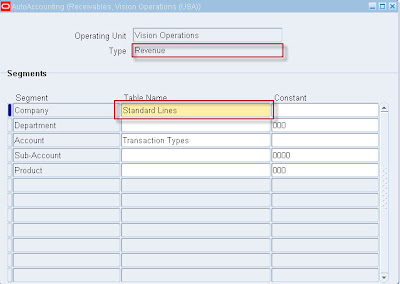
Step2: Setup Memolines with different balancing segments for revenue accounts mapping

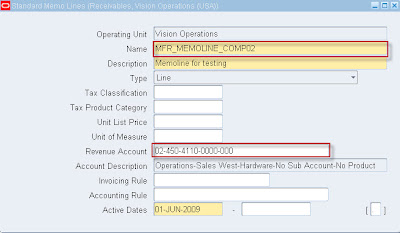
Step 3: Modify SLA definitions for Receivables Application Accounting Definition
a. Create Custom Account Method copying the standard accrual method
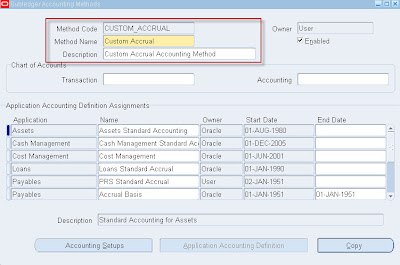
b. Create Custom Application Accounitng Definition copying the default accrual defintiion
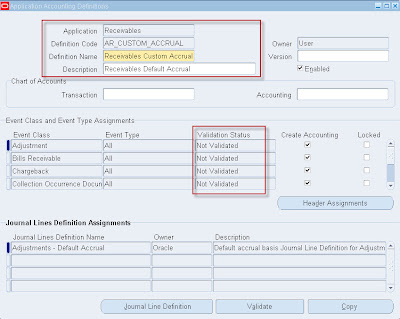
c. Assign the Custom Application Accounting Definition to Custom Accounting Method.
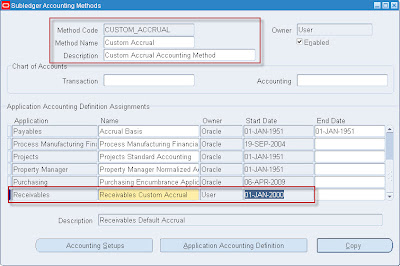
d. Modify the Accounting Definition for Invoice Event Class
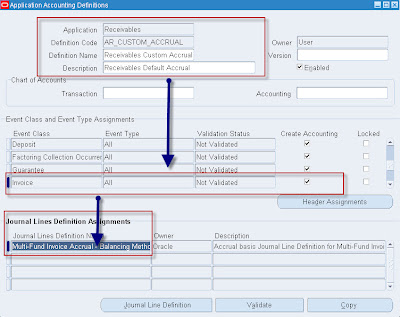
e. Assign the custom Accoutnign Method to Leder using the Accoutnign Setup Manager
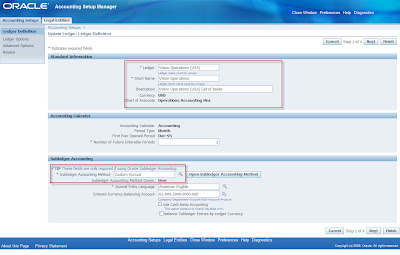
f. Validate the custom Application Accouting Defintitions
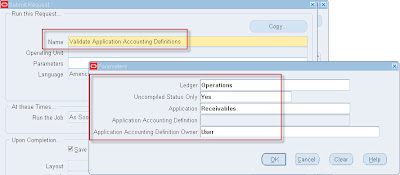
Step 4. Create invoice and check default distributions and accouting entries created by SLA

Requirement:
1. Post Revenue to multiple Revenue accounts with different balancing segment values
2. Generate multiple Receivables Accounts based on different Revenue Accounts on a single invoice.
Functionality:
1. Function similar to Automatic-Offsets with Balacing Segment method in Accounts Payable Module is required.
2. Similar functionality exists in Receivables called Multi Fund Invoice Accrual
Steps:
1. Setup Auto accoutning to generate multiple revenue accounts using standard memo lines on a single invoice with different balancing segment values
2. Autoaccouting will generate default distributions, which are not the final accounting entries
3. Modify Sub Ledger Accounting definitiond
4. Create invoice and check default distributions and accouting entries created by SLA
Note:
- Modifications to be made by event class and testing to be done in test instance.
- Need to create your own Sub Ledger Acconting Method and Application Accounting Definitions (AAD) as sytem will not allow you to modify any thing with owner as Oracle.
Step1: Auto Accounting Setups

Step2: Setup Memolines with different balancing segments for revenue accounts mapping


Step 3: Modify SLA definitions for Receivables Application Accounting Definition
- Create Custom Account Method copying the standard accrual metho
- Create Custom Application Accounitng Definition copying the default accrual defintiion
- Assign the Custom Application Accounting Definition to Custom Accounting Method.
- Modify the Accounting Definition for Invoice Event Class
- Assign the custom Accoutnign Method to Leder using the Accoutnign Setup Manager
- Validate the custom Application Accouting Defintitions
a. Create Custom Account Method copying the standard accrual method

b. Create Custom Application Accounitng Definition copying the default accrual defintiion

c. Assign the Custom Application Accounting Definition to Custom Accounting Method.

d. Modify the Accounting Definition for Invoice Event Class

e. Assign the custom Accoutnign Method to Leder using the Accoutnign Setup Manager

f. Validate the custom Application Accouting Defintitions

Step 4. Create invoice and check default distributions and accouting entries created by SLA

Subscribe to:
Posts (Atom)



